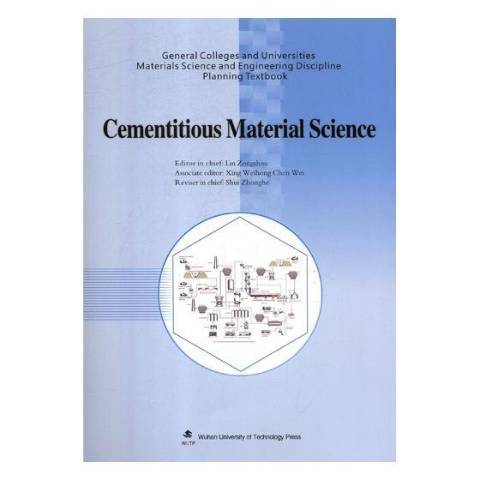《Cementitious Materials Science 膠凝材料學》是2018年武漢理工大學出版社出版的圖書。
基本介紹
- 書名:Cementitious Materials Science 膠凝材料學
- 作者:Deitor in chief Lin Zongshou
- 出版社:武漢理工大學出版社
- 出版時間:2018年8月1日
- 開本:16 開
- 裝幀:平裝
- ISBN:9787562958796
內容簡介,圖書目錄,
內容簡介
《膠凝材料學(英文版)》為新材料科學前沿研究叢書,是普通高等學校材料科學與工程學科規劃教材,以通用矽酸鹽水泥為主,按品種闡述各類膠凝材料的組成、結構與性能的關係,介紹了膠凝材料的水化硬化機理以及改善硬化體結構與性能的途徑。對石膏、石灰、鎂質膠凝材料的生產和套用技術,以及混合材料的組成、特性等也做了詳細介紹。
《膠凝材料學(英文版)》除作為高等學校無機非金屬材料專業、建築工程材料與製品專業本科教學用書教材外,還可供從事建築工程與建築材料工業的有關科研、設計與工程技術人員參考。
圖書目錄
Preface
Chapter 0 Introduction
0.1 Definition and Classification of Cementitious Materials
0.2 The Role of Cementitious Materials in National Economy
0.3 The Brief History of Cementitious Materials
0.4 The Development of Cementitious Materials Science
Chapter 1 Common Portland Cement
1.1 The Invention and Production of Cement
1.1.1 The Invention of Cement
1.1.2 The Process of Cement
1.2 Composition of Portland Cement Clinker
1.2.1 Chemical and Mineral Composition of Clinker
1.2.2 Modulus Value of Clinker
1.2.3 Calculation and Conversion of Mineral Composition of Clinker
1.3 Raw Materials and Raw Materials Proportioning of Portland Cement
1.3.1 Raw Materials of Cement
1.3.2 Clinker Composition Design
1.3.3 Proportioning Calculation of Raw Materials
1.4 Calcination of Portland Cement Clinker
1.4.1 Drying and Dehydration
1.4.2 Decomposition of Carbonate
1.4.3 Solid phase Reaction
1.4.4 Calcination of Clinker
1.4.5 Clinker Cooling
1.4.6 The Role of Other Components
1.4.7 Main Equipments for Clinker Calcination
1.5 Production and Standards for Common Portland Cement
1.5.1 Cement Admixture
1.5.2 Definition, Classification and Specifications for Common Portland Cement
1.5.3 Portland Limestone Cement
1.5.4 Grinding of Cement
1.6 Hydration and Hardening of General Purpose Portland Cemente
1.6.1 Hydration of Cement Clinkers
1.6.2 Hydration of Portland cement
1.6.3 Hydration and Hardening of Portland Cement with
Supplementary Cementitious Materials
1.6.4 Hydration Rate
1.6.5 Hardened Cement Paste
1.7 Properties of Ordinary Portland Cement
1.7.1 Density
1.7.2 Fineness
1.7.3 Water Demand (Consistency, Fluidity)
1.7.4 Setting Time
1.7.5 Strength
1.7.6 Volume Change
1.7.7 Water Retention and Bleeding
1.7.8 Hydration Heat
1.7.9 Heat Resistance
1.7.10 Permeability Resistance
1.7.11 Frost Resistance
1.7.12 Erosion Resistance
Problems
Chapter 2 Characteristic Cements and Special Cement
2.1 Aluminate and High-temperature Resistant Cement
2.1.1 Aluminate Cement
2.1.2 Refractory Castable of Phosphoric Acid and Phosphate
2.1.3 Refractory Castable of Water Glass
2.2 Fast Hardening and High Strength Cement
2.2.1 Fast Hardening Portland Cement
2.2.2 Fast Hardening Sulphoaluminate Cement
2.2.3 Fast Hardening Aluminoferrite Cement
2.2.4 Rapid Hardening Fluoroaluminate Cement
2.2.5 Rapid Hardening and High Strength Aluminate Cement
2.2.6 Super-fast Hardening and Adjustable Setting Aluminate Cement
2.2.7 Special High-strength Cement
2.3 Sulfate-resistant Cement, Moderate Heat and Low Heat Cement and Roads Cement
2.3.1 Sulfate-resistant Cement
2.3.2 Moderate- and Low-heat Portland Cement
2.3.3 Low Heat and Micro Expanding Cement
2.3.4 Low Heat Slag Portland Cement
2.3.5 Road Portland Cement
2.3.6 Steel Slag Cement for Pavement
2.4 Expansive and Self-stressing Cements
2.4.1 Basic Principle of Expansive Cement Production
2.4.2 Types of Expansive Cement
2.4.3 Production Processes and properties
2.5 Oil Well Cement
2.6 Decoration Cement
2.6.1 White Portland Cement
2.6.2 Color Cement
2.7 Masonry Cement
2.7.1 Chinese Standards for Masonry Cement
2.7.2 Industrial Standards for Steel Slag Masonry Cement
2.8 Radiation-proof Cement
2.8.1 Barium Cement
2.8.2 Boron Containing Cement
2.8.3 Strontium Cement
2.8.4 Conducting and Magnetic Cement
2.8.5 Non-magnetic Cement
2.9 Acid-proof Cement
2.9.1 Water Glass Acid-proof Cement
2.9.2 Sulfurous Acid-proof Cement
2.9.3 Polymer Acid-proof Cement
2.10 Low Alkalinity Sulphoaluminate Cement
Problems
Chapter 3 Gypsum
3.1 Raw Materials for Production of Gypsum
3.1.1 Natural Gypsum
3.1.2 Industrial Byproduct Gypsums
3.2 Production of Gypsum Cementitious Materials
3.2.1 Dehydration Transformation of Gypsum
3.2.2 Preparation of Hemihydrate Gypsum
3.3 Building Gypsum
3.3.1 Production of Building Gypsum
3.3.2 Performance and Influencing Factors of Building Gypsum
3.4 Hydration and Hardening Process of I-Iemihydrate Gypsum
3.4.1 Hydration of Gypsum Cementitious Materials
3.4.2 Hydration and Mechanism of Setting and Hardening of Dehydrated Phases
3.4.3 Factors Influence Hydration of Hemihydrate Gypsum
3.4.4 Hardening of Gypsum Paste
3.5 Activation of Auhydrite and Tts Applications
3.5.1 Activation Methods of Anhydrite
3.5.2 Anhydrite Cementing Materials
3.6 Structure and Properties of Hardened Gypsum Paste
3.6.1 Structure of Hardened Gypsum Paste
3.6.2 Strength of Hardened Gypsum Paste
3.6.3 Water Resistance of Hardened Gypsum Paste
3.7 Applications of Gypsum Cementitious Materials
3.7.1 Gypsum Cementitious Materials
3.7.2 Gypsum Products
3.8 Acceptance Check, Storage and Transportation of Gypsum
Problems
Chapter 4 Lime
4.1 Raw Materials for Production of Lime
4.2 Production of Lime
4.2.1 Calcination of Calcium Carbonate
4.2.2 Types of Lime
4.2.3 Characteristics of Architectural Lime
4.2.4 Technical Specifications for Architectural Lime
4.2.5 Activity of Lime
4.3 Hydration of Lime
4.3.1 Hydration of Lime
4.3.2 Characteristics of Lime Hydration
4.4 Structure Formation of Lime Paste
4.4.1 Dissolving and Dispersing of Lime by Water Action
4.4.2 Setting Structure Formation of Lime Paste
4.4.3 Crystalline Structure Formation of Lime Paste
4.5 Hardening of Lime Paste
4.5.1 Crystallization and Attached Strength by Drying
4.5.2 Carbonization
4.6 Applications of Lime
4.6.1 Manufacture of Architectural Quicklime Powders
4.6.2 Production of Slaked Lime Powder or Slaked Lime Slurry
4.6.3 Preparation of Lime Mortar and Grout
4.6.4 Preparation of Lime Soil and Trinity Mixture Fill
4.6.5 Production of Silicate Products
4.6.6 Manufacture of Carbonized Products
4.7 Acceptance Check, Storage, Safekeeping and Transportation of Lime
Problems
……
Chapter 5 Magnesia Cementitious Material
Chapter 6 Other Binders
Problems
Appendix
References

